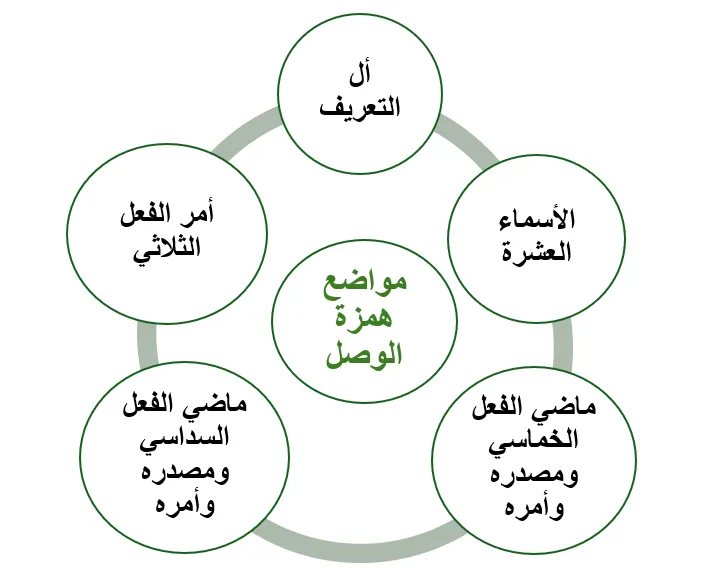What is Hamzat al-Wasl and Hamzat al-Qat ‘? And how do I distinguish between them?
The alif that comes at the beginning of a word—whether the word is a noun or a verb—has only two forms: The first is a silent alif without a hamzah. Its feature is that it is pronounced when it comes at the beginning of speech, as in the underlined word in the following example:
1- I listened to the poem.
But it is not pronounced when it comes in the middle of speech:
2- I read the poet’s biography and listened to his poem.
The second form of the alif at the beginning of a word is that it comes with a hamzah. Its feature is that it is pronounced both at the beginning and in the middle of speech, as in:
3- The jasmine flowers are beautiful.
4- I passed by the garden and saw the jasmine flowers.
Did you notice that the alif in the first example was pronounced at the beginning but was dropped in the middle? And did you notice that the hamzah appeared clearly in examples 3 and 4?
Did you notice that the alif in the first example was pronounced at the beginning but was dropped in the middle? And did you notice that the hamzah appeared clearly in examples 3 and 4? The reason is that Hamzat al-Wasl has no sound when it comes in the middle of speech, which is why it is written without a hamzah (ا), while Hamzat al-Qat‘is always pronounced whether it comes at the beginning or in the middle of speech.
Based on all of the above, Hamzat al-Wasl can be defined as: a silent Alif that comes at the beginning of a word. It is pronounced as a Hamza when it occurs at the start of speech, but it drops when connected to what precedes it. It is written as (ا), an Alif without a Hamza. It appears in a group of nouns, such as: istimā‘ (listening), ijtihād (diligence), istimrār (continuation), and in a specific group of verbs, such as: istama‘a (he listened), ijtahada (he strove), istamarra (he continued). However, it does not occur in particles, because all particles that begin with an Alif are written with Hamzat al-Qat ‘, such as: inna (indeed), ilā (to), aw (or).
Hamzat al-Qat‘can be defined as: a Hamza that is always pronounced, whether at the beginning of speech or when connected. It is written above the Alif (أ) if it carries a fatḥa (a) or ḍamma (u), and below the Alif (إ) if it carries a kasra (i). It occurs in a group of nouns, such as: ihdā’ (dedication), imḍā’ (signature), irsāl (sending), and in a specific group of verbs, such as: ata‘allamu (I learn), aqra’u (I read), ata’ammalu (I reflect). It also appears in all particles that begin with Alif, such as: anna (that/indeed), ammā (as for), idhan (then/therefore).
Where does Hamzat al-Wasl occur?
Hamzat al-Wasl appears in five places in Arabic:
1-The ten nouns:
It appears at the beginning of the following nouns, known as “the ten nouns”:
| 1- aymunu/aymu | 2-ibnam |
| 3- ibn | 4- ibna |
| 5- ithnān | 6- ithnatān |
| 7- imru | 8- imra’a |
| 9- ism | 10- ist |
Whether these nouns are singular or dual, the hamzah remains Hamzat al-Wasl:
| In the nominative case | In the accusative case |
| (ismān) | (ismayn) |
| (imra’atān) | (imra’atayn) |
| (ibnān) | (ibnayn) |
| (ibnatān) | (ibnatayn) |
But it takes Hamzat al-Qat‘if it can be formed as a broken plural: asmā’ (أسماء) – abnā’ (أبناء).
– Examples from the Holy Qur’an for the ten nouns:
أ-“Thāni ithnayn (اثنين) idh humā fī al-ghār idh yaqūlu liṣāḥibihi lā taḥzan inna Allāha ma‘anā” – Sūrat al-Tawbah: 4040.
ب- “Kullu imri’in (امرئ) bimā kasaba rahīn” – Sūrat al-Ṭūr: 21.
ت- “Innī wajadtu imra’atan (امرأة) tamlikuhum wa ūtīyat min kulli shay’ wa lahā ‘arshun ‘aẓīm” – Sūrat al-Naml:22.
ث-“Wadhkurū isma (اسم) Allāh ‘alayhi” – Sūrat al-Mā’idah: 4.
So, each underlined word is a noun that begins with Hamzat al-Waṣl, since it belongs to the ten nouns which always start with Hamzat al-Waṣl—whether singular or dual only.
2- Imperative of the triliteral verb
| Example | Reason |
| Iqraʾ al-kitāb (اقرأ الكتاب) | The word begins with a Hamzat al-Waṣl because it is an imperative triliteral verb. It is identified as triliteral by referring back to its past tense form qaraʾa (قرأ), which consists of three letters. |
Other examples of the imperative triliteral verb:
Ismaʿ (اسمعْ) – Uʿlam (اعلم) – Ifham (افهمْ) – Uktub (اكتُبْ) – Iʿmal (اعملْ) – Irkab (اركبْ) – Idfaʿ (ادفعْ) – Isḥab (اسحبْ) – Irmi (ارمِ) – Ijri (اجرِ) – Irkuḍ (اركُضْ) – Ijmaʿ (اجمعْ) – Iṣnaʿ (اصنعْ).
3- أمر الفعل الخماسي وماضيه ومصدره.
| Example | Reason |
| Ijtahid fī ṭalab al-ʿilm (اجتهدْ في طلب العلمْ) | The word begins with a Hamzat al-Waṣl because it is a quinqueliteral imperative verb. It is identified as quinqueliteral since its past tense form ijtahada (اجتهدَ) consists of five letters. |
| Ijtahada Zaydun (اجتهدَ زيدٌ) | The word begins with a Hamzat al-Waṣl because it is a quinqueliteral past tense verb. |
| Al-ijtihād sabīlu al-najāḥ (الاجتهادُ سبيلُ النجاحِ) | The word begins with a Hamzat al-Waṣl because it is the verbal noun of a quinqueliteral verb. It is identified as quinqueliteral since its past tense form ijtahada (اجتهدَ) consists of five letters. |
Examples of the imperative, past tense, and verbal noun of the quinqueliteral verb from the Qur’an and Hadith:
– “Wa-ḍrib lahum mathalan aṣḥāba al-qaryah idh jāʾahā al-mursalūn” (Surah Yā Sīn: 13). Ḍrib (اضربْ): The word begins with a Hamzat al-Waṣl because it is the imperative form of a quinqueliteral verb.
– “Yā ayyuhā alladhīna āmanū ʿalaykum anfusakum lā yaḍurrukum man ḍalla idhā ihtadaytum” (Surah al-Māʾidah: 105). Ihtadā (اهتدى): The word begins with a Hamzat al-Waṣl because it is a quinqueliteral past tense verb.
– Additional examples: Ibtasim ibtasama ibtisāman (ابتسمْ ابتسمَ ابتساما) Ittaḥid ittaḥada ittiḥādan (اتَّحدْ اتحدَ اتحادا) Iṭṭalaʿ iṭṭalaʿa iṭṭilāʿan (اطَّلعَ اطلعْ اطلاعا) Iʿtani iʿtanā iʿtināʾan (اعتنِ اعتنى اعتناءً) Iʿtamid iʿtamada iʿtimādan (اعتمدْ اعتمدَ اعتمادا) Ittafiq ittifaqa ittifāqan (اتفقْ اتفقَ اتفاقا)
4-The imperative, past tense, and verbal noun of the hexaliteral verb.
| Example | Reason |
| “Istaghfirū rabbakum innahu kāna ghaffārā yursil as-samāʾa ʿalaykum midrārā | Istaghfirū begins with Hamzat al-Waṣl because it is the imperative form of a hexaliteral verb. It is identified as hexaliteral since its past tense form istaghfara contains six letters. |
| Istaghfara Zaydun rabbahu | Istaghfara begins with Hamzat al-Waṣl because it is the past tense of a hexaliteral verb |
| Awṣā al-muṣṭafā ʿalayhi ṣ-ṣalātu wa-s-salām bi-luzūm al-istighfār | al-Istighfār begins with Hamzat al-Waṣl because it is the verbal noun (maṣdar) of a hexaliteral verb. It is identified as hexaliteral since its past tense form istaghfara has six letters. |
– Examples of the imperative, past tense, and verbal noun of the hexaliteral verb:
Istafsirْ – Istafsara – Istifsār, Istantijْ – Istantaja – Istintāj, Istaqbilْ – Istaqbala – Istiqbāl, Istawridْ – Istawrada – Istīrād
| Benefit
For the sake of making it easier to recognize the five-letter verb (al-fiʿl al-khumāsī) and the six-letter verb (al-fiʿl al-sudāsī), along with their verbal nouns, and to distinguish between them: The six-letter verb and its verbal noun usually begin with the three letters Alif (ا), Sīn (س), and Tāʾ (ت), such as: istaʿlama (استعلمَ) – istakhraja (استخرجَ) – istaṭāʿa (استطاع) – istamarra (استمرّ) – istalama (استلم) – istawdaʿa (استودع). As for the five-letter verb (al-fiʿl al-khumāsī) and its verbal noun, they are often characterized by having the third letter as an extra Tāʾ (ت). For example: iʿtazama (اعتزم) – iqtasada (اقتصد) – iftataḥa (افتتح). Their original roots are: ʿazama (عزم) – qaṣada (قصد) – fataḥa (فتح). |
5- Any word that begins with the definite article “al-” (أل التعريف) starts with Hamzat al-Wasl. For example: (al-madrasah – al-ḥadīqah – al-sayyārah – al-ḥaql – al-jāmiʿah – al-muʾassasah – al-muʾtamar).
– Let us summarize the positions of Hamzat al-Wasl:


